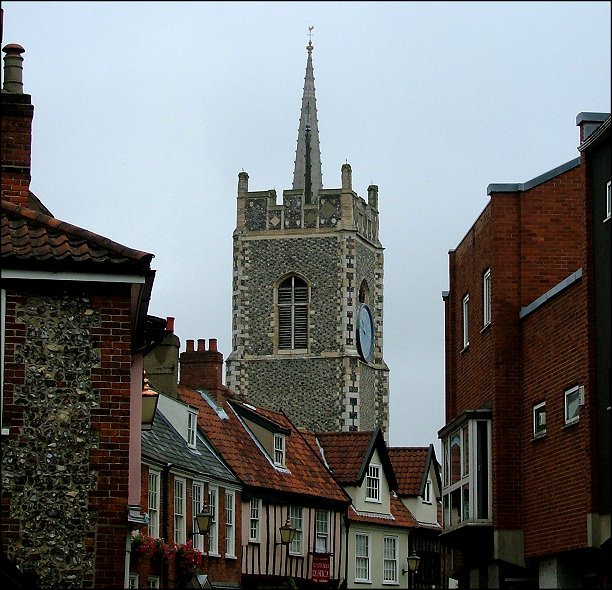| |
|
St George
Tombland, Norwich
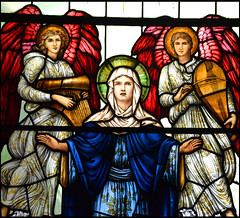 |
|
This
is as pretty a church as you'll find in Norwich,
and the setting is unsurpassed. Hemmed in by
restored 17th and 18th century houses, the church
is set back in one corner of the city's famous
Tombland, just across the road from the Cathedral
of the Great and Undivided Holy Trinity. Indeed,
the church was once known as St George at Trinity
Gate. If you approach the church from Princes
Street, the cathedral spire appears unnervingly
as if it is a little spirelet at the top of St
George. As you reach it, you find it set back
behind mature trees, tight in its little
graveyard. Bequests from the tower date from the
early part of the 15th century, and the rest is
probably broadly contemporary. The very top of
the tower is a 17th century repair in the Gothic
tradition.
Coming from low church Suffolk, St George appears
exotic to my eyes, because it is one one of the
highest rungs of the Anglo-catholic ladder.
Statues and stations abound, and both aisles end
in the east at Marian altars. The furnishings are
largely 19th century, but the chancel retains its
gorgeous 18th century reredos, which is fitting
in a city which was at the height of its power
and influence at that time. |
Also 18th century is the pulpit with its
high tester, both elegant and awe-inspiring. The font
cover is a hundred years earlier, the St George and the
dragon motif on its top a hundred years later. The font
itself is an arcaded job in Purbeck marble, familiar from
hundreds of rural East Anglian churches. This one has
been urbanised by enthusiastic Victorians, placed on
grand marble pillars.
Despite being a small church in a small
parish, St George has provided its fair share of mayors,
and in common with many other city churches retains its
sword and mace holders in the north aisle, decorated with
some of their names. There is also a good range of fairly
impressive memorials. But perhaps the best features are
in glass, five centuries apart. At the east end of the
south aisle is a lovely window of 1937, a late work of
the William Morris workshop depicting the Blessed Virgin
at the Magnificat flanked by angel musicians. The artist
was WH Knight, the angels drawn from Burne Jones
cartoons. You can see a detail from it at the start of
this piece. Further west in the same aisle there is a
16th Century roundel from a domestic Labours of the
Months sequence. It depicts April, the rich man
impatiently dodging the rain that prevents him getting on
with his farming. Across the church, high up in the north
aisle, are two Flemish panels depicting scenes from the
story of Tobit.
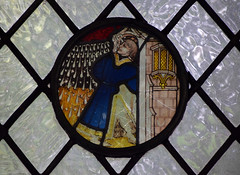  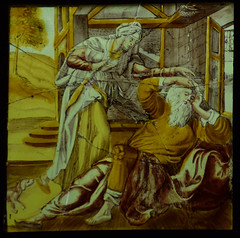
St George has two notable early 17th century
memorials. Up in the chancel is the marvellously named
Alderman Anguish. His monument is by Nicholas Stone. It
is highly coloured, and he kneels opposite his wife,
their family living and dead around them. Another former
mayor is remembered at the west end. John Symonds died in
1609, and left unto the poore of this parish two
shillings a week to be continued forever. Well, ten
pence won't go far these days, but if you are one of the
Tombland poor you might consider looking on the shelf
below it, for this is the original dole table on which
charity payments may be made.
| A
recent review on facebook describes the church as
Catholic, traditional, liberal, friendly,
easy-going, woman-friendly, man-friendly,
gay-friendly, generous-spirited, prayerful,
unfussy, which in my experience of the
church is exactly right. I was most recently here
on the Feast of St Philip and St James in 2017,
which happened to be during the Flintspiration
festival, but Mass went ahead as usual, the
verger at the back welcoming people in to either
carry on looking around during Mass or to sit and
listen to it, as they wished. Afterwards,
it was a pleasure to chat with the cheery verger
and the friendly parish priest, and if I am
honest it was also a pleasure to have my name
recognised. But they were equally lovely to me
before that happened.
|
|
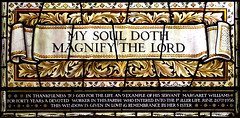 |
Simon Knott, March 2018
|
|
|

